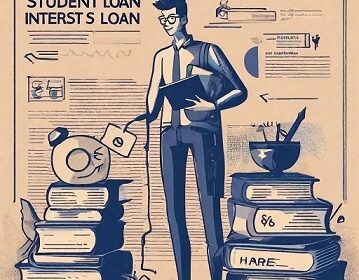Student loan interest rates in 2023 are expected to be influenced by various factors such as inflation, economic growth, and government policies. The current trend of rising interest rates is likely to continue in the coming years, which may result in higher borrowing costs for students.
However, the exact rate of increase will depend on several factors, including the type of loan, the borrower’s credit score, and the lender’s policies. Students are advised to carefully consider their options before taking out a loan and to explore alternative sources of funding such as scholarships, grants, and work-study programs.
Additionally, it is important for borrowers to stay informed about changes in interest rates and to take advantage of opportunities to refinance or consolidate their loans if necessary. Overall, while student loan interest rates in 2023 may be higher than they are today, there are still ways for students to manage their debt and achieve their educational goals.
Student Loan interest rates 2023 are expected to increase due to inflation and economic factors. Borrowers may want to consider refinancing their loans to secure a better rate.
Student Loan Forgiveness programs
Student Loan Forgiveness programs may also be available, but it is important to research eligibility requirements and potential tax implications before pursuing this option. Loan forgiveness programs are designed to help individuals who have taken out loans to pay for their education or other expenses but are struggling to make their payments.
These programs can be offered by the government, non-profit organizations, or private lenders. They typically require the borrower to meet certain eligibility criteria, such as working in a specific field or serving in the military, and may require a certain number of years of service or employment. Once the borrower has met these requirements, a portion or all of their loan may be forgiven, meaning they are no longer required to make payments on that portion of the loan.
Loan forgiveness programs are initiatives that aim to alleviate the financial burden of individuals who have taken out loans. These programs are typically offered by the government or private organizations and are designed to help borrowers who are struggling to make their loan payments. Loan forgiveness programs can take many forms, such as forgiving a portion of the loan balance, reducing interest rates, or extending the repayment period.
Student Debt Relief Strategies
Student Debt Relief: A Ray of Hope
Student debt relief is a pressing concern for millions of Americans. Understanding your options is the first step towards financial freedom. Let’s delve into effective strategies to alleviate the weight of student loans.
Income-Driven Repayment Plans
Income-driven repayment plans are a lifeline for borrowers struggling with high monthly payments. These plans calculate your monthly payment based on your income and family size, ensuring that your loan payments are manageable.
Public Service Loan Forgiveness (PSLF)
For those working in the public sector or non-profit organizations, PSLF can be a game-changer. After making 120 qualifying payments, your remaining student loan balance can be forgiven. It’s a significant relief for those committed to public service.
Refinancing and Consolidation
Refinancing and consolidating your student loans can lead to lower interest rates and simplified payments. However, it’s essential to weigh the pros and cons and choose the option that suits your financial goals.
Student Loan Forgiveness Programs
Various federal and state programs offer loan forgiveness for specific professions, such as teachers, healthcare workers, and military personnel. Research these programs to see if you qualify.
Employer Assistance Programs
Some employers provide student loan repayment assistance as part of their benefits package. This perk can help you make significant strides in paying off your debt.
Budgeting and Financial Planning
Effective budgeting and financial planning can free up extra funds to tackle your student loans more aggressively. Small lifestyle adjustments can lead to significant savings.
Avoiding Default
Defaulting on student loans can have severe consequences, including wage garnishment and damaged credit. Communicate with your loan servicer if you’re facing financial hardship to explore alternative payment arrangements.
Seeking Professional Advice
When navigating the complex landscape of student debt relief, don’t hesitate to seek professional advice. Financial advisors and experts can provide personalized strategies to manage your loans effectively.
FAQs about Student Debt Relief
What is the first step in seeking student debt relief?
The first step is to gather all your loan information, including types of loans, interest rates, and monthly payments. This will help you assess your situation and determine the most suitable relief options.
How can I qualify for Public Service Loan Forgiveness (PSLF)?
To qualify for PSLF, you must work for a government or non-profit organization, make 120 qualifying payments, and be on an income-driven repayment plan. It’s crucial to certify your employment annually.
Is student loan forgiveness taxable?
In some cases, forgiven student loan debt may be considered taxable income. However, certain forgiveness programs, like PSLF, are tax-exempt.
Can I refinance both federal and private student loans?
Yes, you can refinance both federal and private student loans. Keep in mind that refinancing federal loans may make you ineligible for federal forgiveness programs.
How can I avoid student loan default?
To avoid default, communicate with your loan servicer if you’re experiencing financial difficulties. They can help you explore options such as deferment, forbearance, or income-driven repayment plans.
Are there any grants for student debt relief?
How to Fix Broken links of WordPress Sites
While there are limited grants for student debt relief, you can explore scholarships, employer assistance programs, and state-specific programs to alleviate your student loan burden.
These programs are often targeted towards specific groups of borrowers, such as those working in public service or those with high levels of student debt. Loan forgiveness programs can be a valuable resource for borrowers who are struggling to manage their debt and can help them achieve financial stability. can be a valuable resource for those who are struggling financially and can help alleviate the burden of debt.




